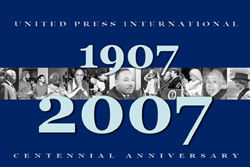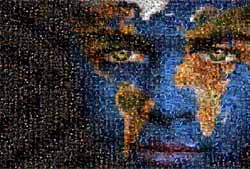1907 - 1910
1911 - 1920
1921 - 1930
1931 - 1940
1941 - 1950
1951 - 1960
1961 - 1970
1971 - 1980
1981 - 1990
1991 - 2000
2001 - Today
|
 |
1950-1953
United Press distinguished itself in coverage of the Korean War, beginning in 1950, when Jack James, manager of the Seoul UP bureau, was the first to report the outbreak of hostilities. On Sunday, June 25, 1950, James had planned to finish a story and then go on a picnic. But he needed his raincoat, which he thought he'd left at the U.S. Embassy. At the embassy door, he met an Army intelligence officer who asked him what he'd heard from the border - and James was surprised to learn that North Korean army units had crossed the 38th Parallel. James spent 90 minutes working to get solid information, and his dispatches were the only reports to reach the United States in time for Sunday morning newspapers. James sent one of his Korean staff members, George Suh, to the front and Suh provided eyewitness reports. Officials in Washington phoned the Seoul embassy to ask whether the UP reports were correct. They were. UP correspondents showed grit and ingenuity in covering the war. Bob Bennyhoff, for example, used a field telephone rigged by the Army Signal Corps to report live to New York (via Tokyo) on a tank battle at the Naktong River in 1950. Later, Bennyhoff attached himself to the Republic of Korea Capital Division, and was allowed to use a mobile radio-teletype for filing. When the Capital Division was first into North Korea, Bennyhoff was first to report it. When the armistice was signed in 1953, correspondent LeRoy Hansen was the only reporter present. Operating on a pool basis, he used a field telephone to dictate a running story for other correspondents to use.
1953
 |
|
Vernon Scott: Pictured here interviewing Marilyn Monroe in an undated file photo (1953). Scott had been a Hollywood reporter and columnist for UPI and its predecessor, United Press, for 52 years. He covered movies, television, actors, directors, producers and other filmmakers, and included many TV and movie stars among his personal friends. Scott also covered political conventions and other national news stories. He provided a radio version of his interviews for 12 years on the UPI Radio Network. (rlw/FILE UPI)
|
Marilyn Monroe loved to flirt. "She was the only woman I interviewed that I ever fell in love with," UPI Hollywood reporter Vernon Scott recalled in 2002, the 40th anniversary of Marilyn's death. Scott covered Hollywood for United Press and UPI for 52 years. After one interview with Monroe, the actress sent Scott a note saying: "You still have a chance with me" -- the kind of flirting Scott said gave her such huge appeal. As he wrote in 2002, a few months before his own death: "Marilyn Monroe was the single most electrifying personality in Hollywood during the 20th century. It was more than a sexual aura, wide-eyed innocence and waiflike vulnerability that touched the hearts of those who knew and loved her." And in another column: "The dazzling, shapely blonde with large, wounded blue eyes and compelling vulnerability was the personification of the ideal American woman, a desirable icon the world over. Marilyn embodied every single female virtue and fault in distressingly delicate and precise components. Every man who loved and respected women was aware of her extraordinary femininity. Women saw themselves in Marilyn incarnate."
1956
Correspondent Russell Jones was one of five correspondents, and the only American, to cover a critical three-week period of the Hungarian revolution late in 1956. He wrote from Budapest: "Life as the only American correspondent left in shattered Budapest is sometimes frightening, sometimes amusing. But mostly it is a continuous feeling of inadequacy both as an American and as a reporter who helplessly watched the murder of a people. For the first time since I was a boy I wept. I saw a former British soldier break down completely. The situation was worse than the Warsaw uprising into which he parachuted in 1944. None of us are Hemingways and it needs a Hemingway to tell this story adequately." Jones mostly filed by telephone - but calls were limited to six minutes at a time. So he arranged calls to Vienna, Frankfurt, Belgrade and Stockholm, dictating six minutes and then calling the next city, picking up where he'd left off in the story. Bureaus relayed their portions of the story to Vienna for compilation. On Dec. 4, Jones was in Heroes Square as more than 30,000 women gathered to lay wreathes and flags at the tomb of the Unknown Soldier. Soviet soldiers around the square jumped from their vehicles with weapons drawn and charged into the crowd. The women held their ground and the soldiers held their fire. Jones dictated the story by phone to Vienna, and the next day he was expelled from Hungary. He wrote on Dec. 10 that "the fiercest fighters were the workers," and added: "It was for these simple, basic things that the Hungarian people fought. These and the right to speak and think freely, to elect men of their own choice, and to raise their children in their own way. They will go on fighting for them." His reporting earned him a Pulitzer Prize.
|


